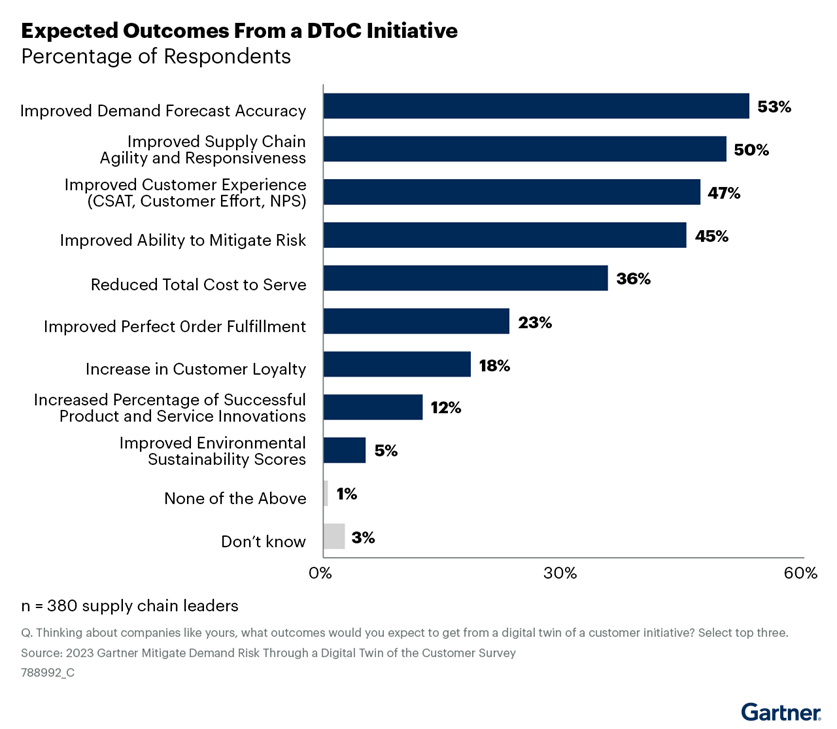While many companies are implementing or testing digital twin technology, a recent Gartner survey of chief supply chain officers found that barely a quarter of companies plan to do the same for their customers.
The survey of 380 supply chain leaders found that 60% are piloting or plan to implement a digital supply chain twin (DSCT), just 27% were planning to incorporate a digital twin of the customer (DToC) as part of their digital strategy.
The results are included in the report, Supply Chain Executive Report: Drive Growth & Elevate Experiences with Digital Twin of the Customer.
Gartner defines DToC as a “dynamic virtual mirror representation of a customer that simulates and learns to emulate and anticipate behavior.” It said that A DToC “can and should complement a broader DSCT.”
Forgetting the customer
“Supply chain leaders understand the importance of the customer in their physical supply chains, but most have not yet translated this lesson to the digital realm,” said Beth Coppinger, senior director analyst in Gartner’s Supply Chain Practice. “The opportunity for transformational benefits from a digital twin of the customer far exceeds the potential that most supply chain leaders see today. A digital supply chain twin that includes a digital twin of the customer can account for changing customer behaviors under a variety of conditions and support the growth plans of the organization.”
IBM has defined a digital twin as a “virtual representation of an object or system that spans its lifecycle, is updated from real-time data, and uses simulation, machine learning and reasoning to help decision-making.”
In essence, a digital twin allows companies to test out changes of material, processes or data inputs to determine how those changes will impact real-world operations.
Research firm MarketsandMarkets predicts the digital twin market will exceed $110 billion by 2028. Gartner found that the few companies that are actively engaging in DToC pilots today are using the technology to help shift from a cost-centric and reactive posture to one that is instead proactive and growth-oriented.
Customer inclusion drives success
The majority (53%) of companies taking a DToC approach expect to see improved demand forecasting, improved supply chain agility (50%), and improved ability to mitigate risk (47%).

(Source: Gartner Supply Chain)
Coppinger said a lack of awareness of DToC’s transformational benefits is holding it back. She noted that 52% of supply chain leaders view artificial intelligence as an “important and disruptive” technology, only 27% feel the same way about DToC. Digital twin supply chains are viewed more favorably, though, at 40%.
Supply chain leaders cited a lack of digitization skills, customer trust and data privacy concerns as primary roadblocks to adoption. Coppinger said the need for the supply chain to integrate and align cross-functionally in areas such as data, talent and investment, are also impediments.
SC
MR


Latest Supply Chain News
- Despite American political environment, global geopolitical risks may be easing
- Joseph Esteves named CEO of SGS Maine Pointe
- Employees, employers hold divergent views on upskilling the workforce
- April manufacturing output slides after growing in March
- Q1 sees a solid finish with positive U.S.-bound import growth, notes S&P Global Market Intelligence
- More News
Latest Podcast

 Explore
Explore
Software & Technology News
- Technology’s role in mending supply chain fragility after recent disruptions
- Tech investments bring revenue increases, survey finds
- Survey reveals strategies for addressing supply chain, logistics labor shortages
- AI, virtual reality is bringing experiential learning into the modern age
- Humanoid robots’ place in an intralogistics smart robot strategy
- Tips for CIOs to overcome technology talent acquisition troubles
- More Software & Technology
Latest Software & Technology Resources

Subscribe

Supply Chain Management Review delivers the best industry content.

Editors’ Picks




